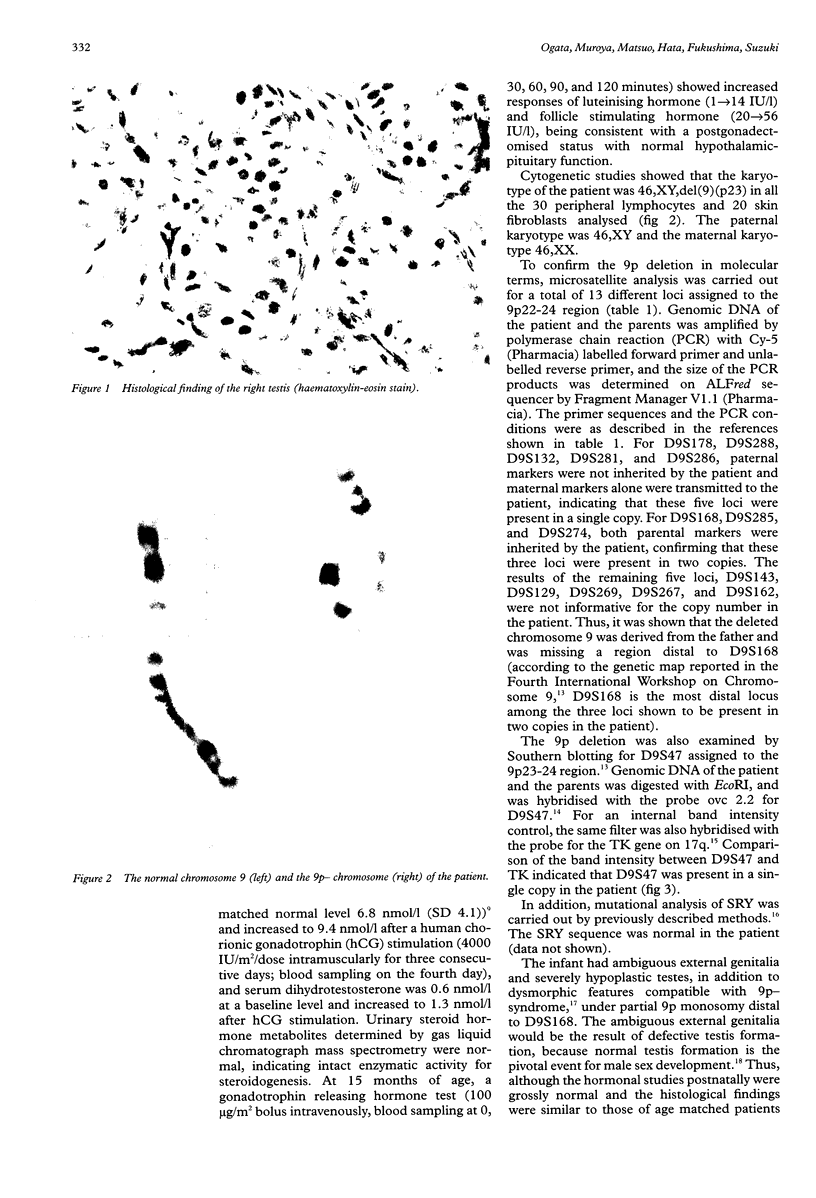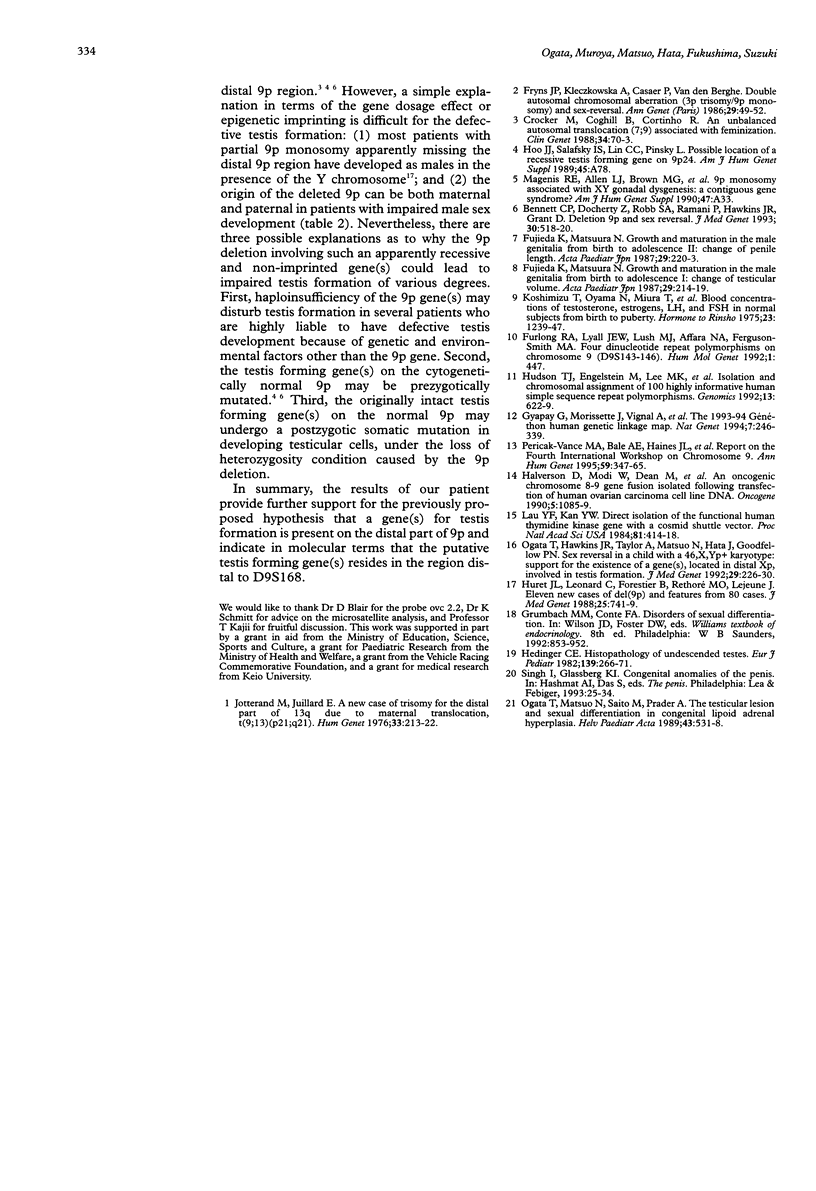Abstract
This paper describes a genetically male infant with impaired male sex development and partial 9p monosomy. The external genitalia were ambiguous with microphallus (penile length at birth 10 mm, mean age matched normal length 29 mm (SD 5)), hypospadias, and hypoplastic scrotum. The tests were undescended and severely hypoplastic (testis size at 12 months of age, right 8 x 5 x 4 mm and left 4 x 3 x 2 mm; mean age matched normal size, length 18 mm (SD 2), width 11 mm (SD 1). Cytogenetic studies showed a 46,XY,del(9)(p23) karyotype in all the 30 peripheral lymphocytes and 20 skin fibroblasts examined. Microsatellite analysis for a total of 13 loci assigned to the 9p22-24 region showed that the deleted chromosome 9 was of paternal origin and was missing a region distal to D9S168. Southern blot analysis for D9S47 also confirmed the 9p deletion. The sequence of SRY was normal. The results provide further support for the previously proposed hypothesis that a gene(s) for testis formation is present on the distal part of 9p and indicate in molecular terms that the putative testis forming gene(s) resides in the region distal to D9S168.
Full text
PDF



Images in this article
Selected References
These references are in PubMed. This may not be the complete list of references from this article.
- Bennett C. P., Docherty Z., Robb S. A., Ramani P., Hawkins J. R., Grant D. Deletion 9p and sex reversal. J Med Genet. 1993 Jun;30(6):518–520. doi: 10.1136/jmg.30.6.518. [DOI] [PMC free article] [PubMed] [Google Scholar]
- Crocker M., Coghill S. B., Cortinho R. An unbalanced autosomal translocation (7;9) associated with feminization. Clin Genet. 1988 Jul;34(1):70–73. doi: 10.1111/j.1399-0004.1988.tb02618.x. [DOI] [PubMed] [Google Scholar]
- Fryns J. P., Kleczkowska A., Casaer P., van den Berghe H. Double autosomal chromosomal aberration (3p trisomy/9p monosomy) and sex-reversal. Ann Genet. 1986;29(1):49–52. [PubMed] [Google Scholar]
- Fujieda K., Matsuura N. Growth and maturation in the male genitalia from birth to adolescence. I. Change of testicular volume. Acta Paediatr Jpn. 1987 Apr;29(2):214–219. doi: 10.1111/j.1442-200x.1987.tb00035.x. [DOI] [PubMed] [Google Scholar]
- Fujieda K., Matsuura N. Growth and maturation in the male genitalia from birth to adolescence. II. Change of penile length. Acta Paediatr Jpn. 1987 Apr;29(2):220–223. doi: 10.1111/j.1442-200x.1987.tb00036.x. [DOI] [PubMed] [Google Scholar]
- Furlong R. A., Lyall J. E., Lush M. J., Affara N. A., Ferguson-Smith M. A. Four dinucleotide repeat polymorphisms on chromosome 9 (D9S143-146). Hum Mol Genet. 1992 Sep;1(6):447–447. doi: 10.1093/hmg/1.6.447. [DOI] [PubMed] [Google Scholar]
- Gyapay G., Morissette J., Vignal A., Dib C., Fizames C., Millasseau P., Marc S., Bernardi G., Lathrop M., Weissenbach J. The 1993-94 Généthon human genetic linkage map. Nat Genet. 1994 Jun;7(2 Spec No):246–339. doi: 10.1038/ng0694supp-246. [DOI] [PubMed] [Google Scholar]
- Halverson D., Modi W., Dean M., Gelmann E. P., Dunn K. J., Clanton D., Oskarsson M., O'Brien S. J., Blair D. G. An oncogenic chromosome 8-9 gene fusion isolated following transfection of human ovarian carcinoma cell line DNA. Oncogene. 1990 Jul;5(7):1085–1089. [PubMed] [Google Scholar]
- Hedinger E. Histopathology of undescended testes. Eur J Pediatr. 1982 Dec;139(4):266–271. doi: 10.1007/BF00442177. [DOI] [PubMed] [Google Scholar]
- Hudson T. J., Engelstein M., Lee M. K., Ho E. C., Rubenfield M. J., Adams C. P., Housman D. E., Dracopoli N. C. Isolation and chromosomal assignment of 100 highly informative human simple sequence repeat polymorphisms. Genomics. 1992 Jul;13(3):622–629. doi: 10.1016/0888-7543(92)90133-d. [DOI] [PubMed] [Google Scholar]
- Huret J. L., Leonard C., Forestier B., Rethoré M. O., Lejeune J. Eleven new cases of del(9p) and features from 80 cases. J Med Genet. 1988 Nov;25(11):741–749. doi: 10.1136/jmg.25.11.741. [DOI] [PMC free article] [PubMed] [Google Scholar]
- Jotterand M., Juillard E. A new case of trisomy for the distal part of 13q due to maternal translocation, t(9;13)(p21;q21). Hum Genet. 1976 Aug 30;33(3):213–222. doi: 10.1007/BF00286845. [DOI] [PubMed] [Google Scholar]
- Koshimizu T., Oyama S., Mihara T., Kudo Y., Fujisawa Y. [Age-related changes of serum testosterone, estrogens, LH and FSH from birth to puberty, and sex differences in the maturation of hypophyseal-gonadal system in childhood]. Horumon To Rinsho. 1975 Dec;23(12):1239–1247. [PubMed] [Google Scholar]
- Lau Y. F., Kan Y. W. Direct isolation of the functional human thymidine kinase gene with a cosmid shuttle vector. Proc Natl Acad Sci U S A. 1984 Jan;81(2):414–418. doi: 10.1073/pnas.81.2.414. [DOI] [PMC free article] [PubMed] [Google Scholar]
- Ogata T., Hawkins J. R., Taylor A., Matsuo N., Hata J., Goodfellow P. N. Sex reversal in a child with a 46,X,Yp+ karyotype: support for the existence of a gene(s), located in distal Xp, involved in testis formation. J Med Genet. 1992 Apr;29(4):226–230. doi: 10.1136/jmg.29.4.226. [DOI] [PMC free article] [PubMed] [Google Scholar]
- Ogata T., Matsuo N., Saito M., Prader A. The testicular lesion and sexual differentiation in congenital lipoid adrenal hyperplasia. Helv Paediatr Acta. 1989 Jun;43(5-6):531–538. [PubMed] [Google Scholar]





